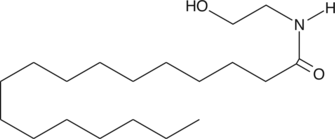Chemicals
Showing 21751–21900 of 41137 results
-
Heclin is an inhibitor of HECT E3 ubiquitin ligases (IC50s = 6.8, 6.3, and 6.9 μM for Smurf2, Nedd4, and WWP1 HECT ligase domains, respectively).{43931} It inhibits autoubiquitination of Smurf2 in HEK293 cells expressing the human enzyme (IC50 = 9 μM) and reduces ubiquitination of Dishevelled 2 in HEK293 cells expressing Smurf2, Nedd4, or WWP2. Heclin is cytotoxic to HEK293 cells (IC50 = 45 μM).
Brand:CaymanSKU:26139 - 5 mgAvailable on backorder
Hecogenin is a natural steroid sapogenin with diverse biological activities that was originally isolated from A. sisalana and has been used in the synthesis of steroids.{38813} It has antioxidant, anti-inflammatory, antiproliferative, and neuroprotective properties.{38814,38815,38816,38817} Hecogenin (10 μM) decreases superoxide anion formation induced by N-Formyl-Met-Leu-Phe (fMLP; Item No. 21495) in rat neutrophils by 23.6%.{38814} It also inhibits myeloperoxidase (MPO) release from human neutrophils activated by phorbol 12-myristate 13-acetate (PMA; Item No. 10008014) when used at a concentration of 1 μg/ml.{38815} Hecogenin inhibits proliferation of the breast cancer cell lines MDA-MB-231, MDA-MB-468, MCF-10A, MCF-7, T47D, BT474, and SK-BR-3 (IC50s = 28.7-38.2 μM).{38816} It decreases the number of glutamate-induced TUNEL-positive primary rat spinal motor neurons by 11% when used at a concentration of 1 μM.{38817} In vivo, hecogenin (15 mg/kg) decreases the mucosal lesion area of ethanol-induced gastric ulceration in mice.{38815} It also decreases tumor volume in an MDA-MB-231 human breast cancer mouse xenograft model when administered at a dose of 10 mg/kg three times per week.{38816}
Brand:CaymanSKU:21372 -Out of stock
Hecogenin is a natural steroid sapogenin with diverse biological activities that was originally isolated from A. sisalana and has been used in the synthesis of steroids.{38813} It has antioxidant, anti-inflammatory, antiproliferative, and neuroprotective properties.{38814,38815,38816,38817} Hecogenin (10 μM) decreases superoxide anion formation induced by N-Formyl-Met-Leu-Phe (fMLP; Item No. 21495) in rat neutrophils by 23.6%.{38814} It also inhibits myeloperoxidase (MPO) release from human neutrophils activated by phorbol 12-myristate 13-acetate (PMA; Item No. 10008014) when used at a concentration of 1 μg/ml.{38815} Hecogenin inhibits proliferation of the breast cancer cell lines MDA-MB-231, MDA-MB-468, MCF-10A, MCF-7, T47D, BT474, and SK-BR-3 (IC50s = 28.7-38.2 μM).{38816} It decreases the number of glutamate-induced TUNEL-positive primary rat spinal motor neurons by 11% when used at a concentration of 1 μM.{38817} In vivo, hecogenin (15 mg/kg) decreases the mucosal lesion area of ethanol-induced gastric ulceration in mice.{38815} It also decreases tumor volume in an MDA-MB-231 human breast cancer mouse xenograft model when administered at a dose of 10 mg/kg three times per week.{38816}
Brand:CaymanSKU:21372 -Out of stock
Hecogenin is a natural steroid sapogenin with diverse biological activities that was originally isolated from A. sisalana and has been used in the synthesis of steroids.{38813} It has antioxidant, anti-inflammatory, antiproliferative, and neuroprotective properties.{38814,38815,38816,38817} Hecogenin (10 μM) decreases superoxide anion formation induced by N-Formyl-Met-Leu-Phe (fMLP; Item No. 21495) in rat neutrophils by 23.6%.{38814} It also inhibits myeloperoxidase (MPO) release from human neutrophils activated by phorbol 12-myristate 13-acetate (PMA; Item No. 10008014) when used at a concentration of 1 μg/ml.{38815} Hecogenin inhibits proliferation of the breast cancer cell lines MDA-MB-231, MDA-MB-468, MCF-10A, MCF-7, T47D, BT474, and SK-BR-3 (IC50s = 28.7-38.2 μM).{38816} It decreases the number of glutamate-induced TUNEL-positive primary rat spinal motor neurons by 11% when used at a concentration of 1 μM.{38817} In vivo, hecogenin (15 mg/kg) decreases the mucosal lesion area of ethanol-induced gastric ulceration in mice.{38815} It also decreases tumor volume in an MDA-MB-231 human breast cancer mouse xenograft model when administered at a dose of 10 mg/kg three times per week.{38816}
Brand:CaymanSKU:21372 -Out of stock
Hecogenin acetate is a steroid sapogenin and an acetylated form of hecogenin (Item No. 21372) that has anthelmintic and antinociceptive properties.{42489,42490,42491} It reduces the percentage of mobile larvae in goat fecal cultures containing Haemonchus, Oesophagostomum, and Trichostrongylus nematodes (EC50 = 0.49 mg/ml).{42489} Hecogenin acetate (5, 10, or 20 mg/kg, i.p.) inhibits development of mechanical hyperalgesia induced by carrageenan, TNF-α, dopamine (Item No. 21992), and prostaglandin E2 (PGE2; Item No. 14010) in mice.{42490} It also increases latency to tail withdrawal in the tail flick test and has no effect on motor performance in the rotarod test in mice when administered at a dose of 40 mg/kg.{42491}
Brand:CaymanSKU:25977 - 1 gAvailable on backorder
Hecogenin acetate is a steroid sapogenin and an acetylated form of hecogenin (Item No. 21372) that has anthelmintic and antinociceptive properties.{42489,42490,42491} It reduces the percentage of mobile larvae in goat fecal cultures containing Haemonchus, Oesophagostomum, and Trichostrongylus nematodes (EC50 = 0.49 mg/ml).{42489} Hecogenin acetate (5, 10, or 20 mg/kg, i.p.) inhibits development of mechanical hyperalgesia induced by carrageenan, TNF-α, dopamine (Item No. 21992), and prostaglandin E2 (PGE2; Item No. 14010) in mice.{42490} It also increases latency to tail withdrawal in the tail flick test and has no effect on motor performance in the rotarod test in mice when administered at a dose of 40 mg/kg.{42491}
Brand:CaymanSKU:25977 - 10 gAvailable on backorder
Hecogenin acetate is a steroid sapogenin and an acetylated form of hecogenin (Item No. 21372) that has anthelmintic and antinociceptive properties.{42489,42490,42491} It reduces the percentage of mobile larvae in goat fecal cultures containing Haemonchus, Oesophagostomum, and Trichostrongylus nematodes (EC50 = 0.49 mg/ml).{42489} Hecogenin acetate (5, 10, or 20 mg/kg, i.p.) inhibits development of mechanical hyperalgesia induced by carrageenan, TNF-α, dopamine (Item No. 21992), and prostaglandin E2 (PGE2; Item No. 14010) in mice.{42490} It also increases latency to tail withdrawal in the tail flick test and has no effect on motor performance in the rotarod test in mice when administered at a dose of 40 mg/kg.{42491}
Brand:CaymanSKU:25977 - 5 gAvailable on backorder
Hederacoside C is a saponin that has been found in K. pictus and has anti-inflammatory activity.{36806,36808} It is an inhibitor of acetylcholinesterase (AChE; IC50 = 31.3 μM).{36808} Hederacoside C (0.5-5 μg) inhibits mutagenicity induced by aflatoxin B1 (Item No. 11293) in S. typhimurium agar cultures from 21 to 67%.{36807} It reduces TNF-α, IL-1β, IL-6, COX-2, and nitric oxide synthase (NOS) levels in a concentration-dependent manner and IL-1 receptor-associated kinase-1 (IRAK1) activity in isolated mouse peritoneal macrophages stimulated by LPS when used at concentrations ranging from 5 to 10 μM.{36806} Hederacoside C (0.02 mg/kg) reduces carrageenan-induced hind paw edema by 37% compared to vehicle control in a rat model of acute inflammation.{36809} It reduces scopolamine-induced memory impairment and increases latency in a passive avoidance test and spontaneous alteration in a Y-maze in mice by 100 and 59%, respectively, when administered at a dose of 40 mg/kg.{36808} Hederacoside C (5 mg/kg, i.p.) reduces serum levels of TNF-α and IL-1β in LPS-challenged mice by 60 and 65%, respectively.{36806}
Brand:CaymanSKU:25138 - 10 mgAvailable on backorder
Hederacoside C is a saponin that has been found in K. pictus and has anti-inflammatory activity.{36806,36808} It is an inhibitor of acetylcholinesterase (AChE; IC50 = 31.3 μM).{36808} Hederacoside C (0.5-5 μg) inhibits mutagenicity induced by aflatoxin B1 (Item No. 11293) in S. typhimurium agar cultures from 21 to 67%.{36807} It reduces TNF-α, IL-1β, IL-6, COX-2, and nitric oxide synthase (NOS) levels in a concentration-dependent manner and IL-1 receptor-associated kinase-1 (IRAK1) activity in isolated mouse peritoneal macrophages stimulated by LPS when used at concentrations ranging from 5 to 10 μM.{36806} Hederacoside C (0.02 mg/kg) reduces carrageenan-induced hind paw edema by 37% compared to vehicle control in a rat model of acute inflammation.{36809} It reduces scopolamine-induced memory impairment and increases latency in a passive avoidance test and spontaneous alteration in a Y-maze in mice by 100 and 59%, respectively, when administered at a dose of 40 mg/kg.{36808} Hederacoside C (5 mg/kg, i.p.) reduces serum levels of TNF-α and IL-1β in LPS-challenged mice by 60 and 65%, respectively.{36806}
Brand:CaymanSKU:25138 - 100 mgAvailable on backorder
Hederacoside C is a saponin that has been found in K. pictus and has anti-inflammatory activity.{36806,36808} It is an inhibitor of acetylcholinesterase (AChE; IC50 = 31.3 μM).{36808} Hederacoside C (0.5-5 μg) inhibits mutagenicity induced by aflatoxin B1 (Item No. 11293) in S. typhimurium agar cultures from 21 to 67%.{36807} It reduces TNF-α, IL-1β, IL-6, COX-2, and nitric oxide synthase (NOS) levels in a concentration-dependent manner and IL-1 receptor-associated kinase-1 (IRAK1) activity in isolated mouse peritoneal macrophages stimulated by LPS when used at concentrations ranging from 5 to 10 μM.{36806} Hederacoside C (0.02 mg/kg) reduces carrageenan-induced hind paw edema by 37% compared to vehicle control in a rat model of acute inflammation.{36809} It reduces scopolamine-induced memory impairment and increases latency in a passive avoidance test and spontaneous alteration in a Y-maze in mice by 100 and 59%, respectively, when administered at a dose of 40 mg/kg.{36808} Hederacoside C (5 mg/kg, i.p.) reduces serum levels of TNF-α and IL-1β in LPS-challenged mice by 60 and 65%, respectively.{36806}
Brand:CaymanSKU:25138 - 25 mgAvailable on backorder
Hederacoside C is a saponin that has been found in K. pictus and has anti-inflammatory activity.{36806,36808} It is an inhibitor of acetylcholinesterase (AChE; IC50 = 31.3 μM).{36808} Hederacoside C (0.5-5 μg) inhibits mutagenicity induced by aflatoxin B1 (Item No. 11293) in S. typhimurium agar cultures from 21 to 67%.{36807} It reduces TNF-α, IL-1β, IL-6, COX-2, and nitric oxide synthase (NOS) levels in a concentration-dependent manner and IL-1 receptor-associated kinase-1 (IRAK1) activity in isolated mouse peritoneal macrophages stimulated by LPS when used at concentrations ranging from 5 to 10 μM.{36806} Hederacoside C (0.02 mg/kg) reduces carrageenan-induced hind paw edema by 37% compared to vehicle control in a rat model of acute inflammation.{36809} It reduces scopolamine-induced memory impairment and increases latency in a passive avoidance test and spontaneous alteration in a Y-maze in mice by 100 and 59%, respectively, when administered at a dose of 40 mg/kg.{36808} Hederacoside C (5 mg/kg, i.p.) reduces serum levels of TNF-α and IL-1β in LPS-challenged mice by 60 and 65%, respectively.{36806}
Brand:CaymanSKU:25138 - 50 mgAvailable on backorder
Hederagenin is a triterpene saponin that has been found in P. eximia with diverse biological activities.{48346,48347,48348,48349,48350} It increases production of reactive oxygen species (ROS), reduces colony formation, and induces apoptosis in cisplatin-resistant head and neck carcinoma (HNC) cells.{48347} In vivo, hederagenin (50, 100, and 200 mg/kg) suppresses tumor growth in a cisplatin-resistant HNC mouse xenograft model. It reduces aortic atherosclerotic lesion area, serum cholesterol and LDL levels, and inducible nitric oxide synthase (iNOS) protein levels in a rat model of atherosclerosis.{48348} Hederagenin (50 mg/kg) reduces ethanol-induced production of TNF-α, IL-6, and COX-2, alcohol dehydrogenase 2 (ALDH2) mRNA expression, and liver damage in a rat model of alcohol-induced hepatotoxicity.{48349} It also induces autophagy and inhibits oligomerization of α-synuclein in a mouse model of Parkinson’s disease induced by MPTP.{48350}
Brand:CaymanSKU:27030 - 100 mgAvailable on backorder
Hederagenin is a triterpene saponin that has been found in P. eximia with diverse biological activities.{48346,48347,48348,48349,48350} It increases production of reactive oxygen species (ROS), reduces colony formation, and induces apoptosis in cisplatin-resistant head and neck carcinoma (HNC) cells.{48347} In vivo, hederagenin (50, 100, and 200 mg/kg) suppresses tumor growth in a cisplatin-resistant HNC mouse xenograft model. It reduces aortic atherosclerotic lesion area, serum cholesterol and LDL levels, and inducible nitric oxide synthase (iNOS) protein levels in a rat model of atherosclerosis.{48348} Hederagenin (50 mg/kg) reduces ethanol-induced production of TNF-α, IL-6, and COX-2, alcohol dehydrogenase 2 (ALDH2) mRNA expression, and liver damage in a rat model of alcohol-induced hepatotoxicity.{48349} It also induces autophagy and inhibits oligomerization of α-synuclein in a mouse model of Parkinson’s disease induced by MPTP.{48350}
Brand:CaymanSKU:27030 - 250 mgAvailable on backorder
Hederagenin is a triterpene saponin that has been found in P. eximia with diverse biological activities.{48346,48347,48348,48349,48350} It increases production of reactive oxygen species (ROS), reduces colony formation, and induces apoptosis in cisplatin-resistant head and neck carcinoma (HNC) cells.{48347} In vivo, hederagenin (50, 100, and 200 mg/kg) suppresses tumor growth in a cisplatin-resistant HNC mouse xenograft model. It reduces aortic atherosclerotic lesion area, serum cholesterol and LDL levels, and inducible nitric oxide synthase (iNOS) protein levels in a rat model of atherosclerosis.{48348} Hederagenin (50 mg/kg) reduces ethanol-induced production of TNF-α, IL-6, and COX-2, alcohol dehydrogenase 2 (ALDH2) mRNA expression, and liver damage in a rat model of alcohol-induced hepatotoxicity.{48349} It also induces autophagy and inhibits oligomerization of α-synuclein in a mouse model of Parkinson’s disease induced by MPTP.{48350}
Brand:CaymanSKU:27030 - 50 mgAvailable on backorder
Hederagenin is a triterpene saponin that has been found in P. eximia with diverse biological activities.{48346,48347,48348,48349,48350} It increases production of reactive oxygen species (ROS), reduces colony formation, and induces apoptosis in cisplatin-resistant head and neck carcinoma (HNC) cells.{48347} In vivo, hederagenin (50, 100, and 200 mg/kg) suppresses tumor growth in a cisplatin-resistant HNC mouse xenograft model. It reduces aortic atherosclerotic lesion area, serum cholesterol and LDL levels, and inducible nitric oxide synthase (iNOS) protein levels in a rat model of atherosclerosis.{48348} Hederagenin (50 mg/kg) reduces ethanol-induced production of TNF-α, IL-6, and COX-2, alcohol dehydrogenase 2 (ALDH2) mRNA expression, and liver damage in a rat model of alcohol-induced hepatotoxicity.{48349} It also induces autophagy and inhibits oligomerization of α-synuclein in a mouse model of Parkinson’s disease induced by MPTP.{48350}
Brand:CaymanSKU:27030 - 500 mgAvailable on backorder
Hederasaponin B is a triterpene saponin that has been found in H. helix and has antiviral and antioxidant activities.{59073,60035} It inhibits the cytopathic effect induced by the enterovirus 71 (EV71) genotypes C3 and C4a (EC50s = 24.77 and 41.77 µg/ml, respectively), as well as reduces expression of the viral structural capsid protein VP2, in Vero cells.{59073} Hederasaponin B (100, 150, and 200 µg/ml) inhibits superoxide generation in human neutrophils.{60035}
Brand:CaymanSKU:30641 - 1 mgAvailable on backorder
Hederasaponin B is a triterpene saponin that has been found in H. helix and has antiviral and antioxidant activities.{59073,60035} It inhibits the cytopathic effect induced by the enterovirus 71 (EV71) genotypes C3 and C4a (EC50s = 24.77 and 41.77 µg/ml, respectively), as well as reduces expression of the viral structural capsid protein VP2, in Vero cells.{59073} Hederasaponin B (100, 150, and 200 µg/ml) inhibits superoxide generation in human neutrophils.{60035}
Brand:CaymanSKU:30641 - 10 mgAvailable on backorder
Hederasaponin B is a triterpene saponin that has been found in H. helix and has antiviral and antioxidant activities.{59073,60035} It inhibits the cytopathic effect induced by the enterovirus 71 (EV71) genotypes C3 and C4a (EC50s = 24.77 and 41.77 µg/ml, respectively), as well as reduces expression of the viral structural capsid protein VP2, in Vero cells.{59073} Hederasaponin B (100, 150, and 200 µg/ml) inhibits superoxide generation in human neutrophils.{60035}
Brand:CaymanSKU:30641 - 25 mgAvailable on backorder
Hederasaponin B is a triterpene saponin that has been found in H. helix and has antiviral and antioxidant activities.{59073,60035} It inhibits the cytopathic effect induced by the enterovirus 71 (EV71) genotypes C3 and C4a (EC50s = 24.77 and 41.77 µg/ml, respectively), as well as reduces expression of the viral structural capsid protein VP2, in Vero cells.{59073} Hederasaponin B (100, 150, and 200 µg/ml) inhibits superoxide generation in human neutrophils.{60035}
Brand:CaymanSKU:30641 - 5 mgAvailable on backorder
Hederoside D2 is a triterpenoid saponin originally isolated from C. robustum rhizome and roots and has diverse biological activities.{48429,48430} It induces potassium release and hemolysis in mouse erythrocytes in a pH-dependent manner when used at a concentration of 10 μg/ml.{48430} Hederoside D2 is cytotoxic to N1E-115 neuroblastoma cells at low pH. It induces proliferation of human embryonic fibroblasts in acidic medium, an effect that can be blocked by the calcium channel blockers verapamil (Item No. 14288), diltiazem, and nitrendipine (Item No. 17549).
Brand:CaymanSKU:27507 - 1 mgAvailable on backorder
Hederoside D2 is a triterpenoid saponin originally isolated from C. robustum rhizome and roots and has diverse biological activities.{48429,48430} It induces potassium release and hemolysis in mouse erythrocytes in a pH-dependent manner when used at a concentration of 10 μg/ml.{48430} Hederoside D2 is cytotoxic to N1E-115 neuroblastoma cells at low pH. It induces proliferation of human embryonic fibroblasts in acidic medium, an effect that can be blocked by the calcium channel blockers verapamil (Item No. 14288), diltiazem, and nitrendipine (Item No. 17549).
Brand:CaymanSKU:27507 - 5 mgAvailable on backorder
Hedgehog (Hh) proteins, important regulators of development, bind the cell-surface protein Patched, allowing activation of Smoothened. In vertebrates, this ultimately leads to the activation of the zinc-finger transcription factors of the Gli family. Overactivation of this pathway contributes to certain cancers, including glioblastoma, for which the Gli proteins are named. Hh antagonist VIII is a cell-permeable quinazolinyl-urea compound that has been shown to inhibit Gli transcription activity with an IC50 value of 70 nM.{26229}
Brand:CaymanSKU:-Hedgehog (Hh) proteins, important regulators of development, bind the cell-surface protein Patched, allowing activation of Smoothened. In vertebrates, this ultimately leads to the activation of the zinc-finger transcription factors of the Gli family. Overactivation of this pathway contributes to certain cancers, including glioblastoma, for which the Gli proteins are named. Hh antagonist VIII is a cell-permeable quinazolinyl-urea compound that has been shown to inhibit Gli transcription activity with an IC50 value of 70 nM.{26229}
Brand:CaymanSKU:-Hedgehog (Hh) proteins, important regulators of development, bind the cell-surface protein Patched, allowing activation of Smoothened. In vertebrates, this ultimately leads to the activation of the zinc-finger transcription factors of the Gli family. Overactivation of this pathway contributes to certain cancers, including glioblastoma, for which the Gli proteins are named. Hh antagonist VIII is a cell-permeable quinazolinyl-urea compound that has been shown to inhibit Gli transcription activity with an IC50 value of 70 nM.{26229}
Brand:CaymanSKU:-Hedgehog (Hh) proteins, important regulators of development, bind the cell-surface protein Patched, allowing activation of Smoothened. In vertebrates, this ultimately leads to the activation of the zinc-finger transcription factors of the Gli family. Overactivation of this pathway contributes to certain cancers, including glioblastoma, for which the Gli proteins are named. Hh antagonist VIII is a cell-permeable quinazolinyl-urea compound that has been shown to inhibit Gli transcription activity with an IC50 value of 70 nM.{26229}
Brand:CaymanSKU:-Helenalin is a sesquiterpene lactone first isolated from various species of Arnica. It has anti-inflammatory effects, most notably by inhibiting gene expression mediated by NF-κB at doses from 1 to 20 µM.{27838,24738} Like other sesquiterpene lactones, helenalin can modify sulfhydryl groups of cysteine residues and it alkylates these groups on the p65 subunit of NF-κB.{27838} It also suppresses the proliferation of cancer cells through multiple mechanisms, including the prevention of signaling through NF-κB.{27836,20972,27837} Helenalin has antibacterial and anti-protozoal activities.{27839,27840}
Brand:CaymanSKU:-Out of stock
Hellebrin is a cardiac glycoside that potently inhibits the Na+/K+-ATPase by binding to it and blocking its non-canonical function as a receptor for cardiac glycosides.{34298,34300} Hellebrin has a higher affinity for the α1β1 subunit of the Na+/K+-ATPase than the α2β1 or α3β1 complexes, in contrast to other cardiac glycosides.{34298} This affinity for the α1β1 complex correlates with its cancer cell growth inhibition (GI50 = 6-58 nM in various human cancer cell lines). Hellebrin also induces caspase-dependent apoptosis in Jurkat T cells.{34299}
Brand:CaymanSKU:21442 -Out of stock
Hellebrin is a cardiac glycoside that potently inhibits the Na+/K+-ATPase by binding to it and blocking its non-canonical function as a receptor for cardiac glycosides.{34298,34300} Hellebrin has a higher affinity for the α1β1 subunit of the Na+/K+-ATPase than the α2β1 or α3β1 complexes, in contrast to other cardiac glycosides.{34298} This affinity for the α1β1 complex correlates with its cancer cell growth inhibition (GI50 = 6-58 nM in various human cancer cell lines). Hellebrin also induces caspase-dependent apoptosis in Jurkat T cells.{34299}
Brand:CaymanSKU:21442 -Out of stock
Helvolic acid is a mycotoxin originally isolated from A. fumigatus that has broad-spectrum antibiotic activity against Gram-positive and Gram-negative bacteria.{33797,33799} At 4-16 mg/L, it acted synergistically with erythromycin (500-2,000 mg/L) in vitro on five multi-drug resistant strains of S. aureus.{33798} At 10 mg/kg/d, it reduced tumor growth and prolonged survival synergistically with cyclophosphamide (20 mg/kg/d) in a mouse model of sarcoma but had no effect when administered alone.{33800}
Brand:CaymanSKU:21580 -Out of stock
Helvolic acid is a mycotoxin originally isolated from A. fumigatus that has broad-spectrum antibiotic activity against Gram-positive and Gram-negative bacteria.{33797,33799} At 4-16 mg/L, it acted synergistically with erythromycin (500-2,000 mg/L) in vitro on five multi-drug resistant strains of S. aureus.{33798} At 10 mg/kg/d, it reduced tumor growth and prolonged survival synergistically with cyclophosphamide (20 mg/kg/d) in a mouse model of sarcoma but had no effect when administered alone.{33800}
Brand:CaymanSKU:21580 -Out of stock
HEMADO is a selective agonist of the adenosine A3 receptor (Kis = 1.1, 327, and 1,230 nM for A3, A1, and A2A receptors, respectively).{35294} HEMADO reduces release of lactate dehydrogenase (LDH) and creatine kinase-MB (CK-MB) from myocardium in isolated rat hearts subjected to ischemia-reperfusion injury.{35295}
Brand:CaymanSKU:21015 -Out of stock
HEMADO is a selective agonist of the adenosine A3 receptor (Kis = 1.1, 327, and 1,230 nM for A3, A1, and A2A receptors, respectively).{35294} HEMADO reduces release of lactate dehydrogenase (LDH) and creatine kinase-MB (CK-MB) from myocardium in isolated rat hearts subjected to ischemia-reperfusion injury.{35295}
Brand:CaymanSKU:21015 -Out of stock
HEMADO is a selective agonist of the adenosine A3 receptor (Kis = 1.1, 327, and 1,230 nM for A3, A1, and A2A receptors, respectively).{35294} HEMADO reduces release of lactate dehydrogenase (LDH) and creatine kinase-MB (CK-MB) from myocardium in isolated rat hearts subjected to ischemia-reperfusion injury.{35295}
Brand:CaymanSKU:21015 -Out of stock
HEMADO is a selective agonist of the adenosine A3 receptor (Kis = 1.1, 327, and 1,230 nM for A3, A1, and A2A receptors, respectively).{35294} HEMADO reduces release of lactate dehydrogenase (LDH) and creatine kinase-MB (CK-MB) from myocardium in isolated rat hearts subjected to ischemia-reperfusion injury.{35295}
Brand:CaymanSKU:21015 -Out of stock
Hematoporphyrin is a photosensitizer.{46544} Hematoporphyrin (3 μM) increases oxygen consumption and decreases the respiratory control ratio (RCR) in irradiated isolated rat liver mitochondria.{46545} It induces DNA breaks in cell-free assays, but not in human HeLa cervical cancer cells, in a light-dependent manner when used at a concentration of 6 μM.{46546} Hematoporphyrin (12 μM) decreases the survival of irradiated, but not non-irradiated, HeLa cells. Hematoporphyrin (5 mg/kg) decreases growth of subcutaneous Yoshida AH-130 hepatoma tumors in rats when administered with radiation.{46547}
Brand:CaymanSKU:28287 - 100 mgAvailable on backorder
Hematoporphyrin is a photosensitizer.{46544} Hematoporphyrin (3 μM) increases oxygen consumption and decreases the respiratory control ratio (RCR) in irradiated isolated rat liver mitochondria.{46545} It induces DNA breaks in cell-free assays, but not in human HeLa cervical cancer cells, in a light-dependent manner when used at a concentration of 6 μM.{46546} Hematoporphyrin (12 μM) decreases the survival of irradiated, but not non-irradiated, HeLa cells. Hematoporphyrin (5 mg/kg) decreases growth of subcutaneous Yoshida AH-130 hepatoma tumors in rats when administered with radiation.{46547}
Brand:CaymanSKU:28287 - 250 mgAvailable on backorder
Hematoporphyrin is a photosensitizer.{46544} Hematoporphyrin (3 μM) increases oxygen consumption and decreases the respiratory control ratio (RCR) in irradiated isolated rat liver mitochondria.{46545} It induces DNA breaks in cell-free assays, but not in human HeLa cervical cancer cells, in a light-dependent manner when used at a concentration of 6 μM.{46546} Hematoporphyrin (12 μM) decreases the survival of irradiated, but not non-irradiated, HeLa cells. Hematoporphyrin (5 mg/kg) decreases growth of subcutaneous Yoshida AH-130 hepatoma tumors in rats when administered with radiation.{46547}
Brand:CaymanSKU:28287 - 500 mgAvailable on backorder
Hemin chloride is an oxidized form of heme that inhibits eukaryotic translation initiation factor 2α kinase 1 (eIF2αK1), a repressor of eIF-2α.{32368} This alters the initiation of mRNA translation, evoking a wide array of cellular effects. Hemin chloride is used experimentally to induce the expression of heme oxygenase-1 in cells and in animals.{32369,32367,32365} Heme extracted from blood is usually oxidized to hemin chloride.{32366,32364} In porphyria, disorders resulting from an increase in porphyrins, hemin chloride serves to activate feedback inhibition of δ-aminolevulinic acid synthase, reducing heme biosynthesis.{32364}
Brand:CaymanSKU:-Out of stock
Hemin chloride is an oxidized form of heme that inhibits eukaryotic translation initiation factor 2α kinase 1 (eIF2αK1), a repressor of eIF-2α.{32368} This alters the initiation of mRNA translation, evoking a wide array of cellular effects. Hemin chloride is used experimentally to induce the expression of heme oxygenase-1 in cells and in animals.{32369,32367,32365} Heme extracted from blood is usually oxidized to hemin chloride.{32366,32364} In porphyria, disorders resulting from an increase in porphyrins, hemin chloride serves to activate feedback inhibition of δ-aminolevulinic acid synthase, reducing heme biosynthesis.{32364}
Brand:CaymanSKU:-Out of stock
Hemin chloride is an oxidized form of heme that inhibits eukaryotic translation initiation factor 2α kinase 1 (eIF2αK1), a repressor of eIF-2α.{32368} This alters the initiation of mRNA translation, evoking a wide array of cellular effects. Hemin chloride is used experimentally to induce the expression of heme oxygenase-1 in cells and in animals.{32369,32367,32365} Heme extracted from blood is usually oxidized to hemin chloride.{32366,32364} In porphyria, disorders resulting from an increase in porphyrins, hemin chloride serves to activate feedback inhibition of δ-aminolevulinic acid synthase, reducing heme biosynthesis.{32364}
Brand:CaymanSKU:-Out of stock
Hemin chloride is an oxidized form of heme that inhibits eukaryotic translation initiation factor 2α kinase 1 (eIF2αK1), a repressor of eIF-2α.{32368} This alters the initiation of mRNA translation, evoking a wide array of cellular effects. Hemin chloride is used experimentally to induce the expression of heme oxygenase-1 in cells and in animals.{32369,32367,32365} Heme extracted from blood is usually oxidized to hemin chloride.{32366,32364} In porphyria, disorders resulting from an increase in porphyrins, hemin chloride serves to activate feedback inhibition of δ-aminolevulinic acid synthase, reducing heme biosynthesis.{32364}
Brand:CaymanSKU:-Out of stock
Heneicosanoic acid is a very long-chain saturated fatty acid found in plants and animals, including human milk fat.{36114,36113,36115} It is also found in R. typhi and R. prowazaekii lipopolysaccharides.{36112}
Brand:CaymanSKU:22593 -Out of stock
Heneicosanoic acid is a very long-chain saturated fatty acid found in plants and animals, including human milk fat.{36114,36113,36115} It is also found in R. typhi and R. prowazaekii lipopolysaccharides.{36112}
Brand:CaymanSKU:22593 -Out of stock
Heneicosanoic acid is a very long-chain saturated fatty acid found in plants and animals, including human milk fat.{36114,36113,36115} It is also found in R. typhi and R. prowazaekii lipopolysaccharides.{36112}
Brand:CaymanSKU:22593 -Out of stock
Heneicosanoic acid methyl ester is an ester form of heneicosanoic acid (Item No. 22593). It has been used as an internal standard in the quantification of fatty acids in dairy products and fatty acid methyl esters in fish by GC-MS.{45183,45184}
Brand:CaymanSKU:26865 - 1 gAvailable on backorder
Heneicosanoic acid methyl ester is an ester form of heneicosanoic acid (Item No. 22593). It has been used as an internal standard in the quantification of fatty acids in dairy products and fatty acid methyl esters in fish by GC-MS.{45183,45184}
Brand:CaymanSKU:26865 - 100 mgAvailable on backorder
Heneicosanoic acid methyl ester is an ester form of heneicosanoic acid (Item No. 22593). It has been used as an internal standard in the quantification of fatty acids in dairy products and fatty acid methyl esters in fish by GC-MS.{45183,45184}
Brand:CaymanSKU:26865 - 250 mgAvailable on backorder
Heneicosanoic acid methyl ester is an ester form of heneicosanoic acid (Item No. 22593). It has been used as an internal standard in the quantification of fatty acids in dairy products and fatty acid methyl esters in fish by GC-MS.{45183,45184}
Brand:CaymanSKU:26865 - 50 mgAvailable on backorder
Heneicosapentaenoic Acid (HPA) is a 21:5 ω-3 fatty acid present in trace amounts in the green alga B. pennata and in fish oils. Its chemical composition is similar to eicosapentaenoic acid (EPA) except elongated with one carbon on the carboxyl end, placing the first double bond in the Δ6 position.{5246} HPA can be used to study the significance of the position of the double bonds in ω-3 fatty acids. It incorporates into phospholipids and into triacylglycerol in vivo with the same efficiency as EPA and docosahexaenoic acid and exhibits strong inhibition of arachidonic acid synthesis from linoleic acid.{5246} HPA is a poor substrate for prostaglandin H synthase (PGHS) (cyclooxygenase) and for 5-lipoxygenase but retains the ability to rapidly inactivate PGHS.{5246}
Brand:CaymanSKU:10670 - 1 mgAvailable on backorder
Heneicosapentaenoic Acid (HPA) is a 21:5 ω-3 fatty acid present in trace amounts in the green alga B. pennata and in fish oils. Its chemical composition is similar to eicosapentaenoic acid (EPA) except elongated with one carbon on the carboxyl end, placing the first double bond in the Δ6 position.{5246} HPA can be used to study the significance of the position of the double bonds in ω-3 fatty acids. It incorporates into phospholipids and into triacylglycerol in vivo with the same efficiency as EPA and docosahexaenoic acid and exhibits strong inhibition of arachidonic acid synthesis from linoleic acid.{5246} HPA is a poor substrate for prostaglandin H synthase (PGHS) (cyclooxygenase) and for 5-lipoxygenase but retains the ability to rapidly inactivate PGHS.{5246}
Brand:CaymanSKU:10670 - 10 mgAvailable on backorder
Heneicosapentaenoic Acid (HPA) is a 21:5 ω-3 fatty acid present in trace amounts in the green alga B. pennata and in fish oils. Its chemical composition is similar to eicosapentaenoic acid (EPA) except elongated with one carbon on the carboxyl end, placing the first double bond in the Δ6 position.{5246} HPA can be used to study the significance of the position of the double bonds in ω-3 fatty acids. It incorporates into phospholipids and into triacylglycerol in vivo with the same efficiency as EPA and docosahexaenoic acid and exhibits strong inhibition of arachidonic acid synthesis from linoleic acid.{5246} HPA is a poor substrate for prostaglandin H synthase (PGHS) (cyclooxygenase) and for 5-lipoxygenase but retains the ability to rapidly inactivate PGHS.{5246}
Brand:CaymanSKU:10670 - 25 mgAvailable on backorder
Heneicosapentaenoic Acid (HPA) is a 21:5 ω-3 fatty acid present in trace amounts in the green alga B. pennata and in fish oils. Its chemical composition is similar to eicosapentaenoic acid (EPA) except elongated with one carbon on the carboxyl end, placing the first double bond in the Δ6 position.{5246} HPA can be used to study the significance of the position of the double bonds in ω-3 fatty acids. It incorporates into phospholipids and into triacylglycerol in vivo with the same efficiency as EPA and docosahexaenoic acid and exhibits strong inhibition of arachidonic acid synthesis from linoleic acid.{5246} HPA is a poor substrate for prostaglandin H synthase (PGHS) (cyclooxygenase) and for 5-lipoxygenase but retains the ability to rapidly inactivate PGHS.{5246}
Brand:CaymanSKU:10670 - 5 mgAvailable on backorder
Heneicosapentaenoic Acid (HPA; Item No. 10670) is a 21:5 ω-3 fatty acid present in trace amounts in green algae and in fish oils. Its chemical composition is similar to eicosapentaenoic acid (EPA; Item No. 90110) except elongated with one carbon on the carboxyl end, placing the first double bond in the Δ6 position.{5246} HPA can be used to study the significance of the position of the double bonds in n-3 fatty acids. It incorporates into phospholipids and into triacylglycerol in vivo with the same efficiency as EPA and docosahexaenoic acid (DHA; Item No. 90310) and exhibits strong inhibition of arachidonic acid (Item No. 90010) synthesis from linoleic acid (Item No. 90150).{5246} Heneicosapentaenoic acid ethyl ester is a more lipophilic, stabilized form of the free acid.
Brand:CaymanSKU:9002624 - 1 mgAvailable on backorder
Heneicosapentaenoic Acid (HPA; Item No. 10670) is a 21:5 ω-3 fatty acid present in trace amounts in green algae and in fish oils. Its chemical composition is similar to eicosapentaenoic acid (EPA; Item No. 90110) except elongated with one carbon on the carboxyl end, placing the first double bond in the Δ6 position.{5246} HPA can be used to study the significance of the position of the double bonds in n-3 fatty acids. It incorporates into phospholipids and into triacylglycerol in vivo with the same efficiency as EPA and docosahexaenoic acid (DHA; Item No. 90310) and exhibits strong inhibition of arachidonic acid (Item No. 90010) synthesis from linoleic acid (Item No. 90150).{5246} Heneicosapentaenoic acid ethyl ester is a more lipophilic, stabilized form of the free acid.
Brand:CaymanSKU:9002624 - 10 mgAvailable on backorder
Heneicosapentaenoic Acid (HPA; Item No. 10670) is a 21:5 ω-3 fatty acid present in trace amounts in green algae and in fish oils. Its chemical composition is similar to eicosapentaenoic acid (EPA; Item No. 90110) except elongated with one carbon on the carboxyl end, placing the first double bond in the Δ6 position.{5246} HPA can be used to study the significance of the position of the double bonds in n-3 fatty acids. It incorporates into phospholipids and into triacylglycerol in vivo with the same efficiency as EPA and docosahexaenoic acid (DHA; Item No. 90310) and exhibits strong inhibition of arachidonic acid (Item No. 90010) synthesis from linoleic acid (Item No. 90150).{5246} Heneicosapentaenoic acid ethyl ester is a more lipophilic, stabilized form of the free acid.
Brand:CaymanSKU:9002624 - 5 mgAvailable on backorder
Heneicosapentaenoic Acid (HPA) is a fatty acid present in trace amounts in the green algae Bryopsis pennata Lamouroux and in fish oils. Its chemical composition is similar to eicosapentaenoic acid (EPA) except elongated with one carbon on the carboxyl end, placing the first double bond in the Δ6 position.{5246} HPA can be used to study the significance of the position of the double bonds in n-3 fatty acids. It incorporates into phospholipids and into triacylglycerol in vivo with the same efficiency as EPA and docosahexaenoic acid (DHA) and exhibits strong inhibition of arachidonic acid synthesis from linoleic acid.{5246} HPA is a poor substrate for prostaglandin H (PGH) synthase and for 5-lipoxygenase but retains the ability to rapidly inactivate PGH synthase.{5246} In certain formulations, HPA methyl ester may serve as a prodrug, which should facilitate uptake of HPA and then be hydrolyzed by esterases to generate the free acid once incorporated into cells. It may also be useful as a reference standard in analytical work.
Brand:CaymanSKU:11622 - 1 mgAvailable on backorder
Heneicosapentaenoic Acid (HPA) is a fatty acid present in trace amounts in the green algae Bryopsis pennata Lamouroux and in fish oils. Its chemical composition is similar to eicosapentaenoic acid (EPA) except elongated with one carbon on the carboxyl end, placing the first double bond in the Δ6 position.{5246} HPA can be used to study the significance of the position of the double bonds in n-3 fatty acids. It incorporates into phospholipids and into triacylglycerol in vivo with the same efficiency as EPA and docosahexaenoic acid (DHA) and exhibits strong inhibition of arachidonic acid synthesis from linoleic acid.{5246} HPA is a poor substrate for prostaglandin H (PGH) synthase and for 5-lipoxygenase but retains the ability to rapidly inactivate PGH synthase.{5246} In certain formulations, HPA methyl ester may serve as a prodrug, which should facilitate uptake of HPA and then be hydrolyzed by esterases to generate the free acid once incorporated into cells. It may also be useful as a reference standard in analytical work.
Brand:CaymanSKU:11622 - 10 mgAvailable on backorder
Heneicosapentaenoic Acid (HPA) is a fatty acid present in trace amounts in the green algae Bryopsis pennata Lamouroux and in fish oils. Its chemical composition is similar to eicosapentaenoic acid (EPA) except elongated with one carbon on the carboxyl end, placing the first double bond in the Δ6 position.{5246} HPA can be used to study the significance of the position of the double bonds in n-3 fatty acids. It incorporates into phospholipids and into triacylglycerol in vivo with the same efficiency as EPA and docosahexaenoic acid (DHA) and exhibits strong inhibition of arachidonic acid synthesis from linoleic acid.{5246} HPA is a poor substrate for prostaglandin H (PGH) synthase and for 5-lipoxygenase but retains the ability to rapidly inactivate PGH synthase.{5246} In certain formulations, HPA methyl ester may serve as a prodrug, which should facilitate uptake of HPA and then be hydrolyzed by esterases to generate the free acid once incorporated into cells. It may also be useful as a reference standard in analytical work.
Brand:CaymanSKU:11622 - 5 mgAvailable on backorder
Hentriacontane is an alkane that has anti-inflammatory activity.{53587} It reduces LPS-induced TNF-α, IL-6, and IL-1β production in RAW 264.7 cells. Hentriacontane (2 and 5 mg/kg) reduces LPS-induced TNF-α, IL-6, and IL-1β production in whole blood and carrageenan-induced paw edema in mice.
Brand:CaymanSKU:29776 - 1 gAvailable on backorder
Hentriacontane is an alkane that has anti-inflammatory activity.{53587} It reduces LPS-induced TNF-α, IL-6, and IL-1β production in RAW 264.7 cells. Hentriacontane (2 and 5 mg/kg) reduces LPS-induced TNF-α, IL-6, and IL-1β production in whole blood and carrageenan-induced paw edema in mice.
Brand:CaymanSKU:29776 - 250 mgAvailable on backorder
Hentriacontane is an alkane that has anti-inflammatory activity.{53587} It reduces LPS-induced TNF-α, IL-6, and IL-1β production in RAW 264.7 cells. Hentriacontane (2 and 5 mg/kg) reduces LPS-induced TNF-α, IL-6, and IL-1β production in whole blood and carrageenan-induced paw edema in mice.
Brand:CaymanSKU:29776 - 500 mgAvailable on backorder
Thioester analogs of glycerophospholipids, in combination with Ellman’s reagent, are convenient colorimetric substrates for the measurement of phospholipase activity. HEPC is a truncated analog of phosphatidylcholine with the entire sn-1 substituent deleted, and with a hexadecylthioester in the sn-2 position.{12915} HEPC is a substrate for Type II phospholipase A2 (PLA2) enzymes, such as porcine pancreatic, bee venom, and snake venom PLA2. The intrinsic biological activity of HEPC has not been actively investigated.
Brand:CaymanSKU:10006695 - 10 mgAvailable on backorder
Thioester analogs of glycerophospholipids, in combination with Ellman’s reagent, are convenient colorimetric substrates for the measurement of phospholipase activity. HEPC is a truncated analog of phosphatidylcholine with the entire sn-1 substituent deleted, and with a hexadecylthioester in the sn-2 position.{12915} HEPC is a substrate for Type II phospholipase A2 (PLA2) enzymes, such as porcine pancreatic, bee venom, and snake venom PLA2. The intrinsic biological activity of HEPC has not been actively investigated.
Brand:CaymanSKU:10006695 - 25 mgAvailable on backorder
Thioester analogs of glycerophospholipids, in combination with Ellman’s reagent, are convenient colorimetric substrates for the measurement of phospholipase activity. HEPC is a truncated analog of phosphatidylcholine with the entire sn-1 substituent deleted, and with a hexadecylthioester in the sn-2 position.{12915} HEPC is a substrate for Type II phospholipase A2 (PLA2) enzymes, such as porcine pancreatic, bee venom, and snake venom PLA2. The intrinsic biological activity of HEPC has not been actively investigated.
Brand:CaymanSKU:10006695 - 5 mgAvailable on backorder
Thioester analogs of glycerophospholipids, in combination with Ellman’s reagent, are convenient colorimetric substrates for the measurement of phospholipase activity. HEPC is a truncated analog of phosphatidylcholine with the entire sn-1 substituent deleted, and with a hexadecylthioester in the sn-2 position.{12915} HEPC is a substrate for Type II phospholipase A2 (PLA2) enzymes, such as porcine pancreatic, bee venom, and snake venom PLA2. The intrinsic biological activity of HEPC has not been actively investigated.
Brand:CaymanSKU:10006695 - 50 mgAvailable on backorder
Heptadecanoic acid is an odd-chain saturated fatty acid that contains seventeen carbons and has been found in milk fat.{31481} Heptadecanoic acid has been used as an internal standard for the quantification of fatty acids in human plasma by LC- and GC-MS and as a biomarker for dairy fat intake.{31481,31484}
Brand:CaymanSKU:19722 -Available on backorder
Heptadecanoic acid is an odd-chain saturated fatty acid that contains seventeen carbons and has been found in milk fat.{31481} Heptadecanoic acid has been used as an internal standard for the quantification of fatty acids in human plasma by LC- and GC-MS and as a biomarker for dairy fat intake.{31481,31484}
Brand:CaymanSKU:19722 -Available on backorder
Heptadecanoic acid methyl ester is an esterified form of heptadecanoic acid (Item No. 19722). It has been found in biodiesel produced by C. sorokiniana microalgae as well as in several types of animal fat biodiesel.{40919,48244} Heptadecanoic acid methyl ester has been used as an internal standard for the quantification of fatty acid methyl esters in human plasma.{48245}
Brand:CaymanSKU:26723 - 1 gAvailable on backorder
Heptadecanoic acid methyl ester is an esterified form of heptadecanoic acid (Item No. 19722). It has been found in biodiesel produced by C. sorokiniana microalgae as well as in several types of animal fat biodiesel.{40919,48244} Heptadecanoic acid methyl ester has been used as an internal standard for the quantification of fatty acid methyl esters in human plasma.{48245}
Brand:CaymanSKU:26723 - 10 gAvailable on backorder
Heptadecanoic acid methyl ester is an esterified form of heptadecanoic acid (Item No. 19722). It has been found in biodiesel produced by C. sorokiniana microalgae as well as in several types of animal fat biodiesel.{40919,48244} Heptadecanoic acid methyl ester has been used as an internal standard for the quantification of fatty acid methyl esters in human plasma.{48245}
Brand:CaymanSKU:26723 - 25 gAvailable on backorder
Heptadecanoic acid methyl ester is an esterified form of heptadecanoic acid (Item No. 19722). It has been found in biodiesel produced by C. sorokiniana microalgae as well as in several types of animal fat biodiesel.{40919,48244} Heptadecanoic acid methyl ester has been used as an internal standard for the quantification of fatty acid methyl esters in human plasma.{48245}
Brand:CaymanSKU:26723 - 5 gAvailable on backorder
Heptadecanoic acid-d3 is intended for use as an internal standard for the quantification of heptadecanoic acid (Item No. 19722) by GC- or LC-MS. Heptadecanoic acid is an odd-chain saturated fatty acid that contains seventeen carbons and has been found in milk fat.{31481} Heptadecanoic acid has been used as an internal standard for the quantification of fatty acids in human plasma by LC- and GC-MS and as a biomarker for dairy fat intake.{31481,31484}
Brand:CaymanSKU:27870 - 1 mgAvailable on backorder
Heptadecanoic acid-d3 is intended for use as an internal standard for the quantification of heptadecanoic acid (Item No. 19722) by GC- or LC-MS. Heptadecanoic acid is an odd-chain saturated fatty acid that contains seventeen carbons and has been found in milk fat.{31481} Heptadecanoic acid has been used as an internal standard for the quantification of fatty acids in human plasma by LC- and GC-MS and as a biomarker for dairy fat intake.{31481,31484}
Brand:CaymanSKU:27870 - 10 mgAvailable on backorder
Heptadecanoic acid-d3 is intended for use as an internal standard for the quantification of heptadecanoic acid (Item No. 19722) by GC- or LC-MS. Heptadecanoic acid is an odd-chain saturated fatty acid that contains seventeen carbons and has been found in milk fat.{31481} Heptadecanoic acid has been used as an internal standard for the quantification of fatty acids in human plasma by LC- and GC-MS and as a biomarker for dairy fat intake.{31481,31484}
Brand:CaymanSKU:27870 - 25 mgAvailable on backorder
Heptadecanoic acid-d3 is intended for use as an internal standard for the quantification of heptadecanoic acid (Item No. 19722) by GC- or LC-MS. Heptadecanoic acid is an odd-chain saturated fatty acid that contains seventeen carbons and has been found in milk fat.{31481} Heptadecanoic acid has been used as an internal standard for the quantification of fatty acids in human plasma by LC- and GC-MS and as a biomarker for dairy fat intake.{31481,31484}
Brand:CaymanSKU:27870 - 5 mgAvailable on backorder
Palmitoyl ethanolamide (PEA) is an endogenous cannabinoid found in brain, liver, and other mammalian tissues.{2415} PEA has also been isolated from egg yolk, and found to have antianaphylactic and anti-inflammatory activity in vitro.{1633} Heptadecanoyl ethanolamide is a synthetic analog of PEA which incorporates an odd-numbered (17-carbon) fatty acid chain. This analog is unlikely to be present in any natural tissue, and so can be used as an internal standard for quantitative analysis. Heptadecanoyl ethanolamide potentiates the Ca2+ influx response to arachidonyl ethanolamide several fold in cells expressing human recombinant VR1.
Brand:CaymanSKU:90342 - 10 mgAvailable on backorder
Palmitoyl ethanolamide (PEA) is an endogenous cannabinoid found in brain, liver, and other mammalian tissues.{2415} PEA has also been isolated from egg yolk, and found to have antianaphylactic and anti-inflammatory activity in vitro.{1633} Heptadecanoyl ethanolamide is a synthetic analog of PEA which incorporates an odd-numbered (17-carbon) fatty acid chain. This analog is unlikely to be present in any natural tissue, and so can be used as an internal standard for quantitative analysis. Heptadecanoyl ethanolamide potentiates the Ca2+ influx response to arachidonyl ethanolamide several fold in cells expressing human recombinant VR1.
Brand:CaymanSKU:90342 - 100 mgAvailable on backorder
Palmitoyl ethanolamide (PEA) is an endogenous cannabinoid found in brain, liver, and other mammalian tissues.{2415} PEA has also been isolated from egg yolk, and found to have antianaphylactic and anti-inflammatory activity in vitro.{1633} Heptadecanoyl ethanolamide is a synthetic analog of PEA which incorporates an odd-numbered (17-carbon) fatty acid chain. This analog is unlikely to be present in any natural tissue, and so can be used as an internal standard for quantitative analysis. Heptadecanoyl ethanolamide potentiates the Ca2+ influx response to arachidonyl ethanolamide several fold in cells expressing human recombinant VR1.
Brand:CaymanSKU:90342 - 5 mgAvailable on backorder
Palmitoyl ethanolamide (PEA) is an endogenous cannabinoid found in brain, liver, and other mammalian tissues.{2415} PEA has also been isolated from egg yolk, and found to have antianaphylactic and anti-inflammatory activity in vitro.{1633} Heptadecanoyl ethanolamide is a synthetic analog of PEA which incorporates an odd-numbered (17-carbon) fatty acid chain. This analog is unlikely to be present in any natural tissue, and so can be used as an internal standard for quantitative analysis. Heptadecanoyl ethanolamide potentiates the Ca2+ influx response to arachidonyl ethanolamide several fold in cells expressing human recombinant VR1.
Brand:CaymanSKU:90342 - 50 mgAvailable on backorder
Heptadecanoyl-coenzyme A (heptadecanoyl-CoA) is a long-chain saturated fatty acyl CoA. It has been used as an internal standard for the quantification of hepatic and mitochondrial fatty acyl CoAs.{43457}
Brand:CaymanSKU:25999 - 1 mgAvailable on backorder
Heptadecanoyl-coenzyme A (heptadecanoyl-CoA) is a long-chain saturated fatty acyl CoA. It has been used as an internal standard for the quantification of hepatic and mitochondrial fatty acyl CoAs.{43457}
Brand:CaymanSKU:25999 - 5 mgAvailable on backorder

























